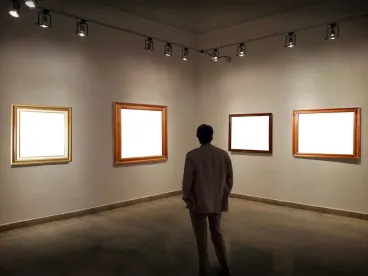UNITED STATES
Police Arrest Oxford Professor for Allegedly Selling Stolen Goods to the Museum of the Bible
Dirk Obbink, Ph.D., an associate professor in papyrology and Greek literature at Oxford, England, has been accused of stealing ancient papyrus fragments from Oxford University’s Sackler Library and selling 13 of the texts to the owners of the Museum of the Bible in Washington, DC. The items in question are papyrus fragments that belong to the Egypt Exploration Society. According to the Society, the early biblical fragments of the gospels are a testament to Egypt’s early Christian heritage. After learning that the texts were stolen, the Museum of the Bible cooperated in returning the texts to the Society, however the Society has identified an additional 120 pieces that are missing from the collection. Obbink insists that the allegations are false and fabricated in an attempt to harm his reputation and career.
New York Judge Rules Video Game “Call of Duty” a Work of Art
In April, a New York federal court judge recognized the medium of video games as an art form when he ruled in favor of video-game developer Activision Blizzard in a lawsuit brought by carmaker AM General. The carmaker alleged that the appearance of Humvees in the video game series “Call of Duty” misled consumers into thinking that AM General licenses the games. The judge ruled that any confusion was minimal because the two companies’ primary markets and products are very different from one another. The judge noted that the U.S. Department of Defense has used Humvees since 1983, making them a universally recognized symbol of the American military, which enhances the realism of the game. Further, the presence of the vehicles in the game is protected as an integral element of artistic expression rather than a willful attempt to garnish the trademark owner’s goodwill for profit.
The Art Community Continues to Suffer Financial Losses Due to the Coronavirus
News about the devastating effects of the coronavirus pandemic is inescapable. A study organized by the Americans for the Arts in conjunction with Artist Relief reports that 95 percent of artists in the United States have lost income due to the coronavirus pandemic and nearly two thirds have become unemployed altogether. Further, in preparing for a $7.4 billion loss in tax revenue, New York City’s fiscal budget for 2021, which will go into effect on July 1, 2020, affords significantly less funding for arts and cultural institutions. However, the pandemic has provided artists with new inspiration and many have sought to document their reactions. Several artists of Asian descent are exploring racism in the pandemic through art; street artists are filling their neighborhoods with coronavirus-themed projects; and an online museum dedicated to art born during the coronavirus quarantine has emerged.
-
Artforum: Bill de Blasio’s Budget for 2021 Significantly Cuts NYC’s Arts Funding
-
Artnews: Metropolitan Museum of Art Lays Off 81 Employees Amid Financial Uncertainty
Galleries Are Finding Creative Ways to Adapt to the Global Crisis
In an effort to stay in business while aiding those in need, many galleries are now donating a percentage of their sales to charity. Galerie Lelong & Co. in New York City is giving 10 percent of the proceeds from its new online group show “Red” to Heart to Heart International, an organization that seeks to improve health access worldwide. In Los Angeles, 60 galleries are launching a joint initiative called “GalleryPlatform.LA.” Beginning on May 15, GalleryPlatform.LA will feature online viewing rooms for 12 member galleries each week, ensuring that each dealer is featured every six weeks. GalleryPlatform.LA seeks to generate sales for its members with “accessibly priced” works of art and build community within the Los Angeles art world, strengthening the ties between galleries, collectors, curators and nonprofits.
EUROPE
Museums Are Commissioning Artists to Create Performances from Their Homes
As much of the world is sequestered in their homes, several international museums including Madrid’s Reina Sofia and the Museum van Hedendaagse Kunst (M HKA) in Antwerp have explored the potential of externally facing spaces, such as balconies and building facades, as artistic outlets. Dubbed “Artists in Quarantine,” museums have commissioned 16 artists to create artworks from their balconies, the first large-scale non-commercial endeavor to arise since countries began sheltering in place. The inspiration for the project was a 1979 piece called “Triangle” by Sanja Iveković, wherein she conducted an 18-minute public performance on her balcony to protest Croatian communist president Tito’s visit to Zagreb. The artistic proposals for “Artists in Quarantine” will be published twice a week over the next two months on Tuesdays and Thursdays.
Dutch Police Seek the Assistance of the Public in Catching a van Gogh Thief
Newly released surveillance footage depicts how a thief was able to steal Vincent van Gogh’s painting The Parsonage Garden at Nuenen in Spring from the Singer Laren Museum in the Netherlands. The thief arrived at the museum on a motorcycle, smashed reinforced glass doors with a sledgehammer and ran out with the painting under his right arm. The heist took place during the early hours of the morning on March 30, 2020. A police spokesperson stated that the thief appeared to target this specific painting, and has called upon any visitors to the museum in the days before its pandemic-related closure on March 14 to come forward with information. So far, the police have received 56 tips from the public, but there have not been any arrests.
Austria and Germany Slowly Allow Reopening of Cultural Institutions While Preparing for Financial Shortcomings
Museums in Austria and Berlin have received clearance to reopen in May, making them among the first cultural institutions in Europe to reopen their doors. In Berlin, authorities have slowly lessened lockdown restrictions for museums effective May 4. However, the city’s mayor is remaining cautious and the German Museum Association issued a list of recommendations for hygiene and safety, including plexiglass shields for ticketing desks, limited visitor numbers and frequent cleaning of galleries. Meanwhile in Austria, museums and other cultural institutions are slotted to reopen in mid-May. However, even with projected reopening goals in place, the social distancing and hygiene-related modifications that come with reopening will not be cheap. The German Museum Association has requested that politicians and sponsors support the museums through this transition period. The international art community will observe closely the effects of these measures to gauge what the future may bring for other regions still on lockdown. The Association of Art Museum Directors (AAMD), made up of directors in the United States, Canada and Mexico, has approved a series of resolutions stating that it will not penalize any museums that reallocate income from endowment funds or donations to cover the costs of general operating expenses for the next two years.
-
The Art Newspaper: AAMD loosens rules for museums seeking to divert income amid coronavirus crisis
-
The Art Newspaper: We went to one of the first German museums to reopen after the lockdown – here’s what it was like
Notre Dame Restoration Site Is Open Again
The Notre Dame construction site reopened on April 27, well ahead of France’s gradual easing of the coronavirus lockdown beginning on May 11. Ten people, including the lead architect and company representatives involved in the restoration efforts, are allowed to enter the base camp to make preparations for additional workers to arrive. Approximately 170 people are staffed to assist on the restoration project. In an effort to limit travel and enforce social distancing, visors and gloves have been purchased for all of the artisan builders and accommodations have been provided in Paris for those workers who reside outside of the city.
-
The Art Newspaper: Notre Dame’s construction site to reopen next week
-
Deutsche Welle: Construction work on Notre Dame begins again
New Website Revealed Latest Technical Findings on Vermeer’s Girl with a Pearl Earring
On April 28 the Mauritshuis Museum unveiled a website detailing the results of an extensive technical analysis of Vermeer’s Girl with a Pearl Earring. In 2018, a group of conservators, scientists and researchers spent two weeks studying the famous painting in a specially constructed glass studio, which enabled members of the public to follow along with the forensic analysis. The project, known as “The Girl in the Spotlight,” explores Vermeer’s technique, including his brushwork, the use of pigments and the buildup of the painting in different layers. No, we still don’t know the name of the Girl, but we now have insight into how Vermeer painted his masterpiece and where he got his pigments. The scientists also confirmed that the Girl with a Pearl Earring does have eyelashes.
-
The Art Newspaper: New secrets of Vermeer’s Girl with a Pearl Earring to be revealed online next week
-
Post Register: Hi-tech scans get under skin of Girl with a Pearl Earring
Viking Artifacts Discovered on Previously Unknown Trade Route in Norway
Due to warming temperatures, nearly 800 Viking artifacts, many of which were frozen for more than 1,000 years, have been discovered in a Norwegian mountain pass. In a melted ice patch on the mountains of Norway’s Innlandet County, archaeologists discovered a leather shoe, a woolen mitten, a tunic, feathered arrowheads, horseshoes, a horse snowshoe and kitchen utensils, indicating that the mountain pass served as an important trade route within the Viking world. Archaeologists believe that the route was likely used to transport goods such as cheese, butter, and reindeer pelts and antlers between Viking farms from 300 to 1500 AD. The discoveries are part of the growing field of glacial archaeology that has been made possible as climate change shrinks ice flows around the world.
ASIA
Director of Beijing’s Center for Contemporary Art Comments on Lessons the Institution Has Learned in the Wake of the Pandemic
As he prepares for a new show, “Meditations in an Emergency,” Philip Tinari, the director and chief executive of the UCCA Center for Contemporary Art in Beijing, comments that life during the pandemic has presented the opportunity to think about “who we are and where we want to go, without the pressures of constant activity.” Now as China tries to bounce back from the pandemic, at the entrance to most public buildings one must scan a quick response (QR) code that runs the individual’s mobile data to confirm that he or she has been in town for at least 14 days, and arrivals from China must show the notarized results of a COVID-19 nucleic acid test performed in the past seven days when checking into Beijing hotels. “Meditations in an Emergency” seeks to comment on the new normal of even stricter surveillance and control.




 />i
/>i

